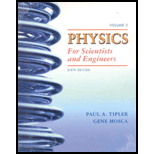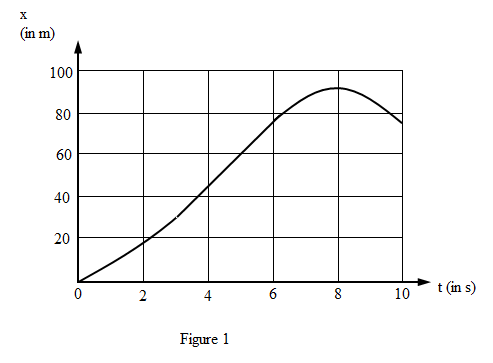
Concept explainers
(a)
The average acceleration of given particle.
(a)
Answer to Problem 63P
The average acceleration in interval AB is
Explanation of Solution
Given:
The variation of velocity of particle with time is plotted.
Formula used:
Write the expression for average acceleration.
Here,
Calculation:
Substitute
Substitute
Substitute
Conclusion:
Thus, the average acceleration in interval AB is
(b)
The positionof particle after given time interval.
(b)
Answer to Problem 63P
The particle is located at distance
Explanation of Solution
Formula used:
The displacement of the particle from the velocity-time graph is given by the area under the curve of the plot for the particular time interval.
The area under the graph for the interval
Write the expression for the area under the curve for the first interval.
Here,
The area under the graph for the interval
Write the expression for the area under the curve for the second interval.
Here,
The area under the graph for the interval
Write the expression for the area under the curve for the third interval.
Here,
The area under the graph for the interval
Write the expression for the area under the curve for the fourth interval.
Here,
Write the expression for displacement.
Here,
Calculation:
Substitute
Substitute
Substitute
Substitute
Substitute
Conclusion:
Thus the particle is located at distance
(c)
The plot of displacement of particle as a function of time
(c)
Answer to Problem 63P
The plot of displacement time graph is shown ion figure 1.
Explanation of Solution
The time interval BC is with constant velocity so in displacement time graph interval of BC will be straight line

Conclusion:
Thus, the plot of displacement time graph is shown ion figure 1.
Want to see more full solutions like this?
Chapter 2 Solutions
Physics for Scientists and Engineers, Vol. 3
- Let s(t) = ae^(1−t^2) be a function for the position in millimeters of a particle as a function of timein seconds.(a) Find expressions for the velocity and acceleration of the particle as a function of time. (b) If the particle is at position 2 mm at time 0 seconds, find a. (c) Using the value of a that you found in (b), what direction is the particle traveling inafter 2 seconds?arrow_forwardMost important in an investigation of an airplane crash by the U.S. National Transportation Safety Board is the data stored on the airplane’s flight-data recorder, commonly called the “black box” in spite of its orange coloring and reflective tape.The recorder is engineered to withstand a crash with an average deceleration of magnitude 3400g during a time interval of 6.50 ms. In such a crash, if the recorder and airplane have zero speed at the end of that time interval, what is their speed at the beginning of the interval?arrow_forwardIf you divide the total distance traveled on a car trip (as determined by the odometer) by the elapsed time of the trip, are you calculating average speed or magnitude of average velocity? Under what circumstances are these two quantities the same?arrow_forward
- plot the position of a particle as afunction of time for an object dropped from rest for the time of 0 seconds to 1.2 seconds in time intervals of 0.2 seconds. the position of an object in free fall is described by the equation y(t)=0.5gt^2+vot+yoarrow_forwardThe acceleration of a particle as a function of time is given as a= kt, where, a is linear acceleration in m/s2, k is proportionality constant in m/s3 and t is time inseconds. At countdown time t= 0 second, the velocity of a particle v=3 m/s. Knowing the condition that both the velocity and position are zero at countdown time t=5 seconds; write down the final general equations of motion of the particle as a function of time.arrow_forwardA train is traveling down a straight track at 32 m/s when the engineer applies the brakes, resulting in an acceleration of −1.0 m/s2 as long as the train is in motion. How far does the train move during a 64-s time interval starting at the instant the brakes are applied in meters?arrow_forward
- A particle moves along the x-axis so that it’s position at any time t≥0t≥0 is given by x(t)=t3−3t2+t+1x(t)=t3−3t2+t+1. For what values of t, 0≤t≤30≤t≤3 , is the particle’s instantaneous velocity the same as its average velocity on the closed interval [0, 3]? Your solution should clearly show all steps leading to the answer as well as justification for it.arrow_forwardFor an object, for example a car, which is constantly decelerating, which of the following would be an appropriate position versus time graph?arrow_forwardTraveling with an initial speed of 70 kph, a car accelerates at 6000 km/hr2 along a straight road. How long will ittake to reach a speed of 120 kph? Also, through what distance does the car travel during this time?arrow_forward
- The position of a particle moving along the x axis varies in time according to the expression x=2t2-3t+5 where x is in meters and t is in seconds. Evaluate its position at the following times. a)Find the displacement from 1s to 3s. b)Find the average velocity from 1s to 3s.c)Find the instantaneous velocity as a function of time.d)Find the velocity at 1s to 3s d)Find the average acceleration from 1s to 3s.e)Find the instantaneous accelerationarrow_forwardA runner with a good awareness of her pace runs along a path of unknown length at a speed of 0.275 mi/min and then walks back to her starting point at a speed of 0.0500 mi/min. She neglects to note her time for each part of her path, but does measure the total round trip time to be 60.0 min. How far did she run? Do not include the walking distancearrow_forwardTo be able to solve rectilinear problems with variable functions. A particle moves in a straight line in such a way that its displacement s, in inches, from a given reference point at successive 1 sec intervals from 0 to 6, both inclusive, is 4.1, 4.5, 4.2, 3.0, 1.45, 0.40, 0 respectively. Plot the displacement-time curve. From this curve find the velocity for each value of t. From the velocity-time curve find the acceleration for each value of t.arrow_forward
 University Physics Volume 1PhysicsISBN:9781938168277Author:William Moebs, Samuel J. Ling, Jeff SannyPublisher:OpenStax - Rice University
University Physics Volume 1PhysicsISBN:9781938168277Author:William Moebs, Samuel J. Ling, Jeff SannyPublisher:OpenStax - Rice University Principles of Physics: A Calculus-Based TextPhysicsISBN:9781133104261Author:Raymond A. Serway, John W. JewettPublisher:Cengage Learning
Principles of Physics: A Calculus-Based TextPhysicsISBN:9781133104261Author:Raymond A. Serway, John W. JewettPublisher:Cengage Learning

